Embodied Carbon: Australian Property’s Ticking Timebomb

Global examples show us the way to hit our carbon targets by 2050
Sustainability and ESG are hot topics being pursued with vigour by the property industry. An oft overlooked aspect of this is embodied carbon.
If Australian government policy follows the lead of other western countries, it will soon be mandatory for new development and refurbishments to consider and limit embodied carbon impacts. This would reset development viability calculations and be likely to render adaptive reuse far more appealing than new construction with significant implications for developers, landowners and land use planners.
What is embodied carbon?
The Green Building Council Australia (GBCA) defines embodied carbon as:
“The sum of greenhouse gas emissions released during the following stages of a building: raw material extraction, transportation, manufacturing, construction, maintenance, renovation, demolition, recycling, and reuse.”
Essentially, it is the carbon that is locked into a building and which stands to be emitted when it is altered through repositioning, refurbishment or demolition.
Figure 1 – The embodied carbon lifecycle of a building

Why does it matter?
Given that real estate accounts for 40% of global carbon emissions, the industry is rapidly pivoting towards sustainability. In 2019, embodied carbon accounted for just 16% of the whole lifecycle carbon impact of a typical building (Figure 1), with 84% of emissions related to operations – lifts, lighting, heating and the like.
Because of energy efficiency measures and electricity decarbonisation, by 2050 some 85% of emissions will relate to embodied carbon. As a result, there will be far greater attention on reducing the embodied carbon impacts of real estate by preserving and reusing existing stock rather than knocking it down and rebuilding.

Pricing embodied carbon. What might be coming?
At the moment, Australian real estate’s decarbonisation efforts are led by investors, landowners, developers and occupiers. Soon though, it is likely that policy and legislation will force better environmental practices, as has been happening overseas.
Since January 2023, building regulations in Denmark mandate life cycle assessments (LCAs) for all new developments and refurbishments of over 1,000 sqm to quantify their carbon impact over 50-years. A limit value is imposed of 12 kg of carbon dioxide per sqm per year of operational and embodied carbon, with offsetting required if this is exceeded. Sweden has since January 2022 required new developments to quantify and submit their carbon emissions in their planning applications.
In New York, new rules implemented in September 2022 force government capital projects such as infrastructure to use more sustainable materials and assessment in order to reach carbon neutrality by 2050. Annual LCAs are needed on all new construction, additions and substantial building works. In October 2023, they will also need to provide action plans for cutting embodied carbon.
France’s RE2020, which came into effect in January 2022, seeks to reduce carbon impacts from building operations and new construction. This includes defining maximum thresholds for the amount of embodied carbon which can be emitted in new development and refurbishment, with acceptable limits falling over time.
Australia is behind the curve on forcing LCA and embodied carbon disclosures, but if the government is serious about meeting its goal to become net zero by 2050, this is an essential step.
What does it mean for the Australian built environment?
Accounting for whole lifecycle carbon will fundamentally reset development viability calculations in Australia. It will significantly increase new development costs and incentivise measures to limit or reduce embodied carbon impacts via offsetting, sustainable materials and adaptive reuse.
Developers and landowners will need to find more creative ways to reuse existing buildings for new purposes when their existing use is no longer economically viable. This will have big implications for secondary offices in particular that are unsuited to modern occupier standards and need reinvention. In the past these could simply be demolished and rebuilt, in the future that may not be possible.
The challenge of finding new uses for tired buildings will fall most heavily on land use planners. Rigorous planning restrictions will not provide the flexibility that allow the most viable uses to be supported – residential in former offices for example. Carrot and stick incentives like grants, density bonuses or financial contributions may be necessary to force buildings adaptation for the benefit of maximising the efficient and effective use of land, as owners may otherwise be happier for them to lie predominately or fully vacant if it avoids the need for additional investment.
In some global cities (US and UK), city authorities are exploring ways in which they can improve the financial viability for conversion projects to stimulate development through means such as tax breaks, contribution waivers and density bonuses.
It would be wise for all stakeholders to start accounting for embodied carbon today, for example by preserving easily adaptable buildings and using construction materials with less carbon impact such as timber.
Doing so will mitigate greater environmental and financial costs tomorrow.
Related posts
Dive deeper into insights that matter to you.

The Election and Housing: Ireland’s Wake-Up Call for Oz

Australia’s Visitor Economy Rebounds: Insights from 2024-2025 ABS Data

Australian Data Centres: The State of Play for this Critical Sector

30 Years On: Has Docklands Been A Success?
Make smarter decisions
Get in touch with the Team to get an understanding of how we transform data into insightful decisions. Learn more about how Atlas Economics can help you make the right decisions and create impact using our expertise.
